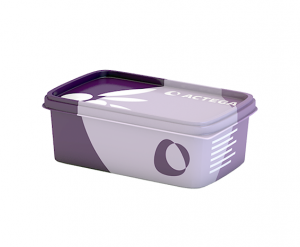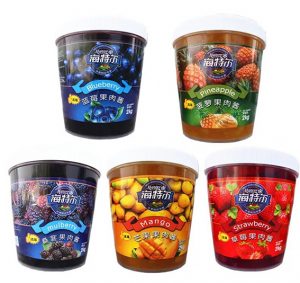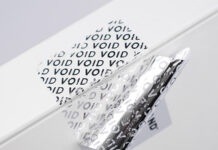 Actega organized recently a webinar about this very hot topic: Andre Soterio, Head of Sales Labels EMEA and Frank Kamphuis, Head of R&D Waterbased Coatings & Adhesives Permeable Substrates spoke about this fascinating technology, the perfect strategy to attract consumers for every kind of product that needs a container
Actega organized recently a webinar about this very hot topic: Andre Soterio, Head of Sales Labels EMEA and Frank Kamphuis, Head of R&D Waterbased Coatings & Adhesives Permeable Substrates spoke about this fascinating technology, the perfect strategy to attract consumers for every kind of product that needs a container
What are the many ways to decorate a product?
Andre Soterio: “You can decorate a product with self-adhesive labels, one of the most used application technologies that represents about 40% of labelling market globally. The glue applied and wrap-around labels have a very big market share worldwide, representing 35%. Shrink sleeves are very popular for its 360° decoration. IML applications represent about 2% of the global labelling market worldwide and is very popular in Europe especially the injection process used for tubs, pails, and small containers”.

Can you tell us more about IML?
Andre Soterio: “IML market is a very technical, innovative market. Just a few companies have the technical know-how to produce good quality IML labels and it is not easy for new printers to start an IML production. For this reason it is necessary the knowledge of one of the main components to this production method, the coatings.
One of the main reason companies use IML is because a product can be fully decorated in one step. While the production of the plastic is in progress, the product is simultaneously being decorated, resulting in time being saved during the production process. It is a very high value decoration. In addition, printing quality is high: high-resolution image, detailing and sharp barcodes. Depending on the film used and design, you can create a label that is fully integrated into the packaging, as if the label wasn’t there”.
Is this process sustainable?
Frank Kamphuis: “Yes, IML labels can be recycled together with the packaging. This process uses less plastic in production, and it achieves a very high-cost efficiency for high quantities of products as well. In addition, customers can easily switch from one product to the other, just by changing the labels during the production. Further to this, IML offers a very high resistance against abrasion chemicals, humidity, heat, and frost”.
What are the most used coatings for IML?
 Frank Kamphuis: “There is a lot to consider when speaking of IML coatings, such as printing properties, quick drying, curling, heat resistance, static charging, and water resistance. Two of the main and widely used coating technologies in the market are UV coatings and water-based coatings. Each technology present advantages and disadvantages. There are also other technologies available but not so popular, like solvent based, LED or Electron-Beam”.
Frank Kamphuis: “There is a lot to consider when speaking of IML coatings, such as printing properties, quick drying, curling, heat resistance, static charging, and water resistance. Two of the main and widely used coating technologies in the market are UV coatings and water-based coatings. Each technology present advantages and disadvantages. There are also other technologies available but not so popular, like solvent based, LED or Electron-Beam”.
Andre Soterio: “In Europe, 90% of the printers are currently using water-based solutions. Only a small number are using UV coatings, however this number is constantly increasing”.
What are the advantages and disadvantages of UV coating?
Andre Soterio: “The advantage of using UV is the high gloss. It is very difficult to match the high gloss that you get with UV compared to a water-based coating. The second main advantage is the rub resistance, better than water-based coatings. Then there is the higher coating thickness, higher mechanical resistance, and chemical resistance. Depending on the product, UV coatings will always have an overall better resistance.
On the other hand, UV coatings have a strong rub resistance, they have a very low water resistance. Another disadvantage is the cost of UV coatings, which are much more expensive than water-based coatings. Sometimes you can also come across adhesion problems and in this case, you will need to use a primer to improve it.
One of the defining points is the static pinning during the injection process, this is the most critical point when choosing an IML coating, but it is very important for the injection molder that he can place the labels in the mold using the static pinning process. When using UV, depending on the way you apply it might lead to some static pinning problems at the injection, while with water-based coatings, the process is much more stable.
Besides you must change the lamps often to develop a good curing of the labels and consequently, good quality. But one of the main disadvantages of UV coatings is the food contact and migration issues. Although there are available several low migration UV coatings, end users are still reluctant to adapt UV coatings for direct food applications. Someone might say that IML labels are not in direct contact with the food. But during or just after the production of IML containers, the products are stacked to facilitate the transport and in this moment, the coating is in direct contact with the interior of the packaging, exactly where the food is placed and a set-off migration might occur. It can lead to the coating migrating into the food. For this reason, brand owners tend to avoid using UV in some cases”.
And what are the advantages of water-based coatings?
 Andre Soterio: “They have more advantages than disadvantages. One of them is the fact that they can come into direct food contact. As the majority of IML usage is for food application, brand owners want to be 100% sure that no harmful substances are migrating to the food products.
Andre Soterio: “They have more advantages than disadvantages. One of them is the fact that they can come into direct food contact. As the majority of IML usage is for food application, brand owners want to be 100% sure that no harmful substances are migrating to the food products.
Water-based coatings are much easier to control due to its water resistance, so when water is gone, you are left with a very nicely dried polymer film. It has a better static control during printing and die cutting too, but most importantly when you need to apply the static pinning to place the label inside the mold, the water-based coating will perform as expected.
Those are a few of the main reasons why people use water-based coatings, because they are a very reliable system. Besides the flatness of the labels is assured and it can be even used for overlapping applications, like margarine tubs. And it provides an economical advantage as well”.
What technical aspects are most importantly for IML coatings?
Frank Kamphuis: “They are four: mixing well the coatings, anilox selection and maintenance, dryer set up and choosing the right coating for the right application.
If the coating is not well mixed, it will not be obtained the correct combination of polymers to achieve the best performance of the coating and it can generate several issues, from longer drying times, blocking of labels, deficient static charging and set off in the mold.
As regards anilox, we have seen the best results with hexagonal engraving and an anilox with between 15 and 17cm³/m² when using offset oxidative inks and between 11 and 13cm³/m² for UV or LED inks. Another important aspect is the regular cleaning of the anilox, to be sure that the correct amount of coating is constantly applied”.
The dryer set up is a topic that sometimes is not taken seriously. As the offset machines have an option to have an automatic set up, some printers do not take the time to adjust the dryer manually. The dryer needs to be adjusted depending on the ink coverage, speed and film used and most important is to have less heat and temperature and maximum air flow and avoid high pile temperatures.
And finally, the correct selection of the coating for the right application. A standard IML coating can be used in 80%, but sometimes there are some special requirements that a standard coating will not fulfil. For example, visual aspects, like high gloss, matt or even a drip off effect. And then special characteristics, like pasteurization resistant products, overlapping, high water resistance or haptic effects. Even luminescent coatings, that can be seen with UV black light, are used nowadays.






















